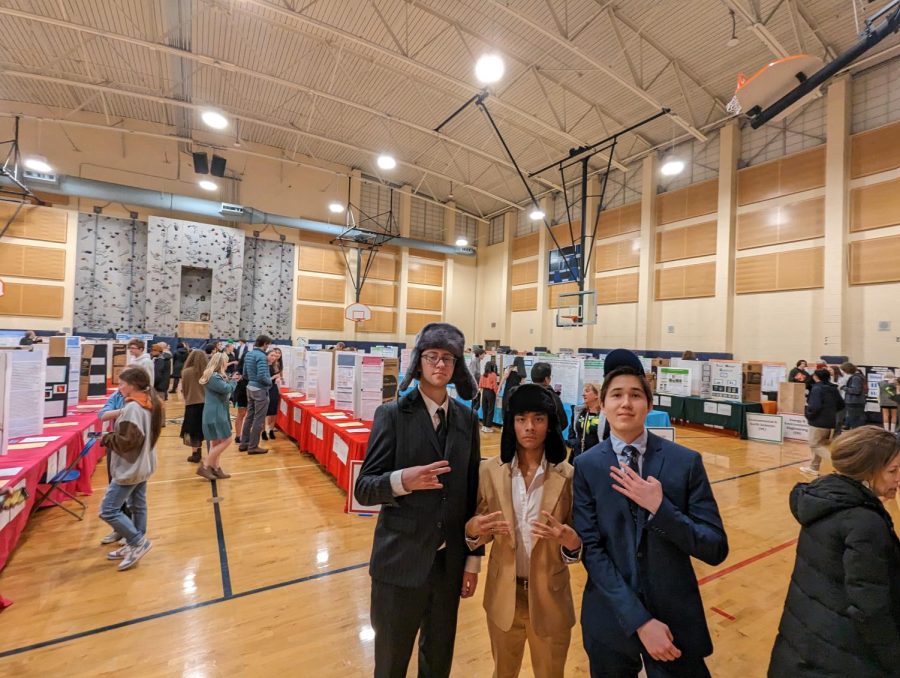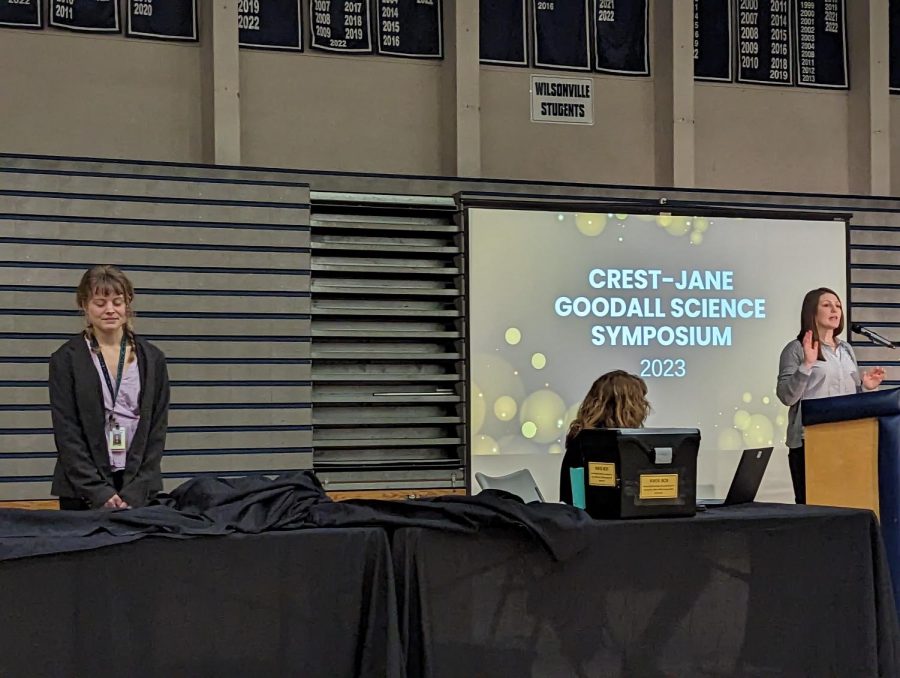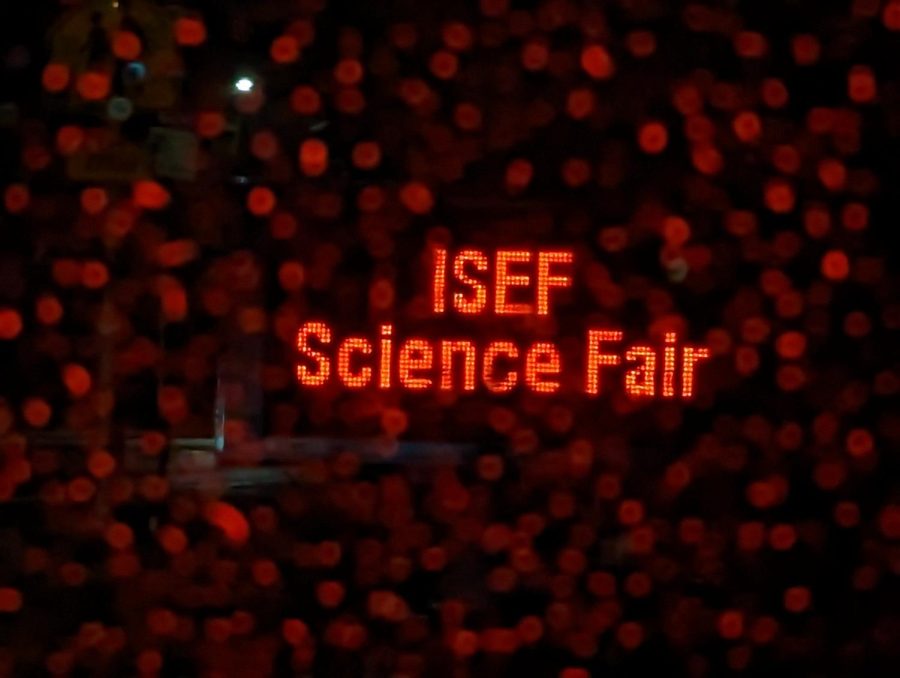Students Compete at the CREST Jane Goodall Science Symposium
March 3, 2023
February 27th and 28th were big days for many students in our school district. Since last September– or even June– students have designed and run experiments to test their hypotheses; maybe even to improve the world. Now comes the time to present their projects, and maybe even win big: the district-level science fair.
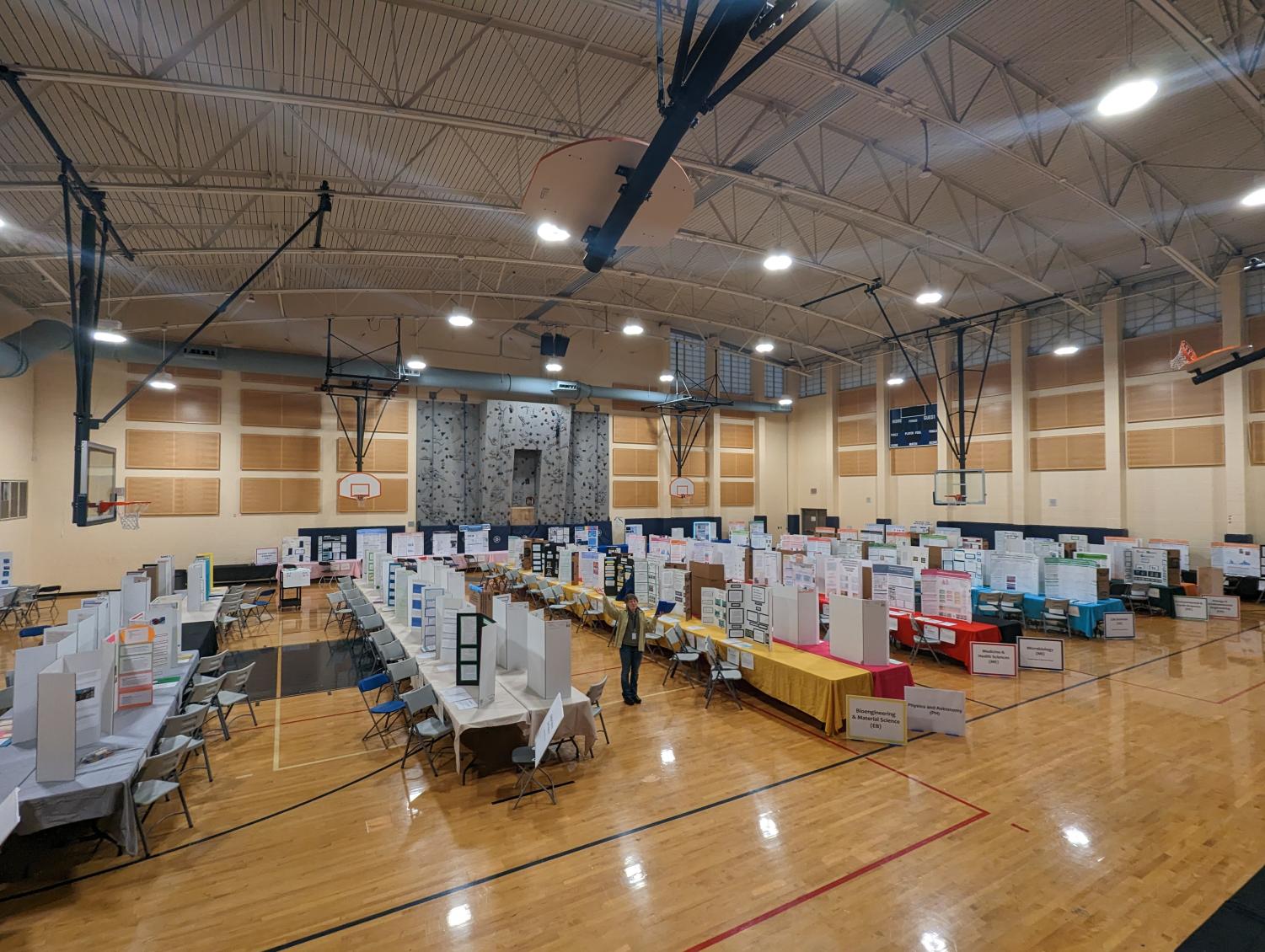
Setting up for the fair takes a long time. Students set up their boards, logbooks, and research plans over the weekend in preparation for judging on Monday.
Nerves before presentations
Students set up over the weekend– both Saturday and Sunday– for the fair. This meant posters, logbooks, research plans, abstracts, and props, lined up neatly on their booths. Chairs were under those tables at precise 45-degree angles. The whole exhibit hall was precise, methodical– just like research is.
Junior Ava Riddle says, “It was great to see all of the work my partner and I had put in finally come together.”
Setup was busy and a few seniors flitted around the gymnasium to run display and safety checks, clipboard in one hand and pass slips in another. After setting up their posters, students went home to practice their “elevator pitches”, which were 1-minute summaries of what they did, why they did it, and how it turned out.
Senior Soren Tucker says that for his team, “the main concern was the memorization of what we should say, as well as who is saying what, and how fast we were talking.” Talking too fast may leave the judges unsure of what you’ve just said. Taking a brisk speed without being too leisurely ensures that content gets across, yet it is not overwhelming to the tired judges.
For Tucker’s team, “another huge concern was our dress attire.” Their team found it difficult to decide on what to wear. Often, group projects coordinate their clothes to the same level of professionality, so they look like a team when they present. Senior Henri Villeneuve, on Tucker’s team, says that he was “anxious and nervous” and joked that he “needed emotional support,” which his teammates helped with.
Aside from pitches and attire, posters are very important too. Tucker says his team was worried about their board. “We believed that it was going to ruin our hopes of being successful.”
But besides worries, his teammates Villeneuve and Senior Anthony Herrera were excited to participate in judging, and to get treats after the judging session. “We’re eager to get Otter Pops from Ms. Smith,” says Herrera. Excitement was present and growing until the judging sessions began mid-Monday.
Judging fares well
Soren Tucker, Anthony Herrera, and Henri Villeneuve stand amidst a busy exhibit hall. They are excited about their project.
Don’t we all love being in a warm gymnasium with over 200 students, plus over 50 judges, all competing for the same few advancements spots? Well, it’s more fun when it’s a science fair, and there are detailed posters all around to look at, and numerous interesting people to talk with.
So, how does judging work? Judges – volunteers from the community – walk around the exhibit hall to read posters in their assigned categories in the morning. Students file in after lunch, from both West-Linn and Wilsonville, for a full afternoon of poster-presentation judging. Over the afternoon, judges visit each booth to ask the student more about their work and answer any clarifying questions they have. This is when elevator pitches and props are useful – they help the student explain their project in detail. Students come from middle and high schools from across our school district. This year, over 150 projects participated in total!
This was senior Soren Tucker’s first fair. Tucker says, “It was great to see people who are experts in the field give us feedback on our project, and hear that they’re interested in the project.” Some judges jump into questions while others want to hear a detailed story from start to finish – they just want to hear all about the hard work you’ve done over the past year. Everyone’s excited!
Junior Ava Riddle enjoyed her judging session. “The judges we had were really good,” she says. They were “genuinely interested” and “asked us great questions.” Although Riddle and her partner were “pretty scared to talk to them at first,” they realized they had the information, and it was “just about the confidence I said it with.”
Students got varying numbers of sticky tabs on their board – indications of how many judges had talked to them. Some categories averaged 4 sticky tabs while others averaged 10, depending on what the judge-student ratios were. Categories are the broad subject which the project falls into. There were behavioral, engineering, computer science, biology, environmental science, physics, and more categories of projects in the exhibit hall.
Junior Kate Kurata says, “being able to speak with experts who understand my project and befriending them as well” was one of her favorite parts of the judging experience. Freshman Arush Goswami enthusiastically adds, “Some even came back and talked to us later to know more!”
As the three-hour judging session came to a close, students talked in excited whispers to neighboring students as Mrs. Danielle Schroeder picked up a mic and announced details on how everyone would be exiting the exhibit hall – also known as the aux gym. There were middle schoolers and highschoolers from across the district who had to board the right busses to get home on time, so the exhibit hall was busy as everyone exited. The event was coordinated to the very last detail by our amazing fair coordinators Mrs. Danielle and Ms. Emma Smith, and it ran smoothly!
Now, the students anticipate the awards ceremony the next night…
Awards in the gymnasium
The Award Ceremony took place in the main gymnasium. It was a quick awards ceremony, due to very icy weather outside.
The awards ceremony was held in the main gymnasium, but to start off, there was a public viewing, where students and parents and community members could learn about each others’ projects in a semi-casual format in the exhibit hall. Right outside the large aux-gym windows, everyone could see the gentle snowflakes fall. They’d been falling all day long.
Then something no one expected: a short power outage – about a second or so. Over the speaker came an announcement that the public viewing was cut short by 20 minutes and everyone was herded into the main gym to find their seats. Student participants sat by categories, with parents scattered on the bleachers.
Junior Kate Kurata says, “The snow situation was a bummer.” Everything had to be ran at 2x speed.
The ceremony started with a welcome, and then moved to the Keynote Speaker, Mrs. Nicole Day. Working towards her pHd in bioengineering, she gave a speech titled “Engineering Immune Cell Responses Using Magnetic Particles.”
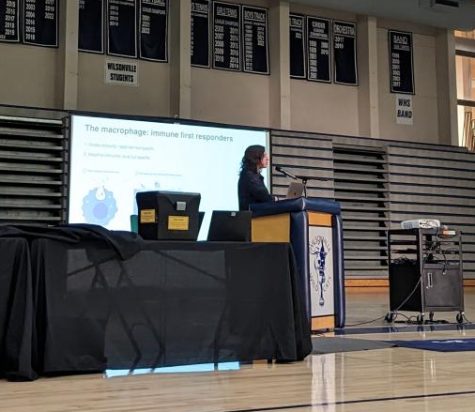
The speech was interesting, but the anticipation of awards held taut over the audience. When awards started, they were recited “lickety split” (anonymous quote). First Special awards, then CREST awards, then the Special-Special awards.
Junior Ava Riddle and her teammate won a Special award for In-Vitro Biology.
Kurata won big in the Special-Special awards. “I’m so excited for the awards I received. An OSU scholarship, and a biomedical award from Regeneron,” who is the title sponsor of ISEF itself! “I didn’t expect to win anything,” says Kurata, “so it was a shock!”
The ISEF community is really supportive and celebrates whoever wins, so after every award, there were countless high-fives and fist-bumps; numerous claps and cheers!
Meanwhile, Freshman Arush Goswami, who worked on a project with his brother this year, says “I was pretty nervous, especially when it seemed like they were going through endless Special awards without us winning any.”
Then to category awards – HM, third, second, and first places.
Goswami says, “When we finally got called for first place in Computer Science, I was full of joy!”
Seniors Soren Tucker, Henri Villeneuve, and Anthony Herrera also placed third in their category.
Finally, the NWSE (state fair) and ISEF (international fair) were announced.
Numerous students, including Kurata, Riddle’s team, Tucker’s team, and Goswami’s team advanced to NWSE, which will take place at PSU on April 3rd.
The top four projects were announced at the very end: the Best of Fair who were selected for the International Science and Engineering Fair at Dallas, in the third week of May. Students selected get an all-expenses-paid trip to compete internationally for ISEF Team Oregon, their schools, and themselves, to win cash and merit prizes.
Goswami was one of two Wilsonville HS students who won Best of Fair. “I was really happy as we spent a lot of time on this project and it paid off,” he says. “From what I have heard, ISEF internationals is a life changing experience and is extremely fun so I am so excited to go to Dallas and compete with worldwide competition.”
The other student who qualified from Wilsonville HS was Aditi Bhaskar. (“Yes, I’m writing in the third person,” she says unironically.) “I am super excited for my third year as an ISEF finalist, and last year’s experience at Atlanta was the best and most fun I’ve ever had.” She won third in her category at Internationals last year, and hopes to win bigger this time around!
With that, the night almost concluded – except for a short thank-you speech, coordinated by West Linn and Wilsonville Seniors to the wonderful fair coordinators, Mrs. Danielle and Ms. Emma!
Dispersal was quick, faster than past years, since the roads, especially out in West Linn, were becoming more icy and dangerous with every minute of hesitation.
“I’m glad it all worked out in the end,” says Kurata. Goswami was “a bit sad we couldn’t have the whole award ceremony because of the snow, but I am very excited for what lies next in ISEF for me!”
It was a fun night and an awesome conclusion to this year’s fair.
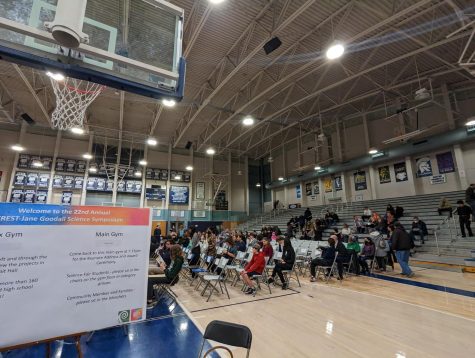
2023 CJGSS Winners
CJGSS – The CREST- Jane Goodall Science Symposium – is an affiliated fair with ISEF, the International Science and Engineering Fair. Over 81 countries participate at ISEF. Our school district sends the top four projects each year to compete at ISEF.
Here is a <complete list of awards> (West Linn and Wilsonville) from this year’s fair! Good luck to all students participating at State and International levels!

